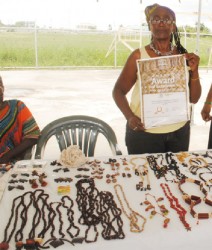After we had finished speaking with Juliana Hughes on Monday she had to ready herself to travel to Florida the next day to participate in the Guyana Trade, Tourism and Investment Expo 2014. Local craftspeople set much store by overseas events and perhaps more than most Hughes believes that events like the Florida Expo are a commercial lifeline for the local craft community. She is not alone among her compatriots who believe that at least 75 per cent of the purchases in the craft sector are made by foreigners.
The 59-year-old Rastafarian is an outspoken critic of what she believes is a widespread local indifference to indigenous craft. Having travelled to and stayed in other countries on the continent including Suriname and Brazil, she says she finds the propensity by Guyanese to distance themselves from local craft disturbing. At least in part, she says, it is a consequence of a strong tradition of wearing gold jewellery. She says that elsewhere in the hemisphere indigenous jewellers are well-respected and that the locals wear their jewellery with pride.
She had, it seems, thought that her return to Guyana in 2005 and the launch by herself and her husband Wesley George of the commercial craft establishment Jah Works might precipitate a measure of growth in the sector. By the time she had returned to Guyana, GuyExpo had already been launched and since 2005 she has been attending the event. She sees it as a rare window of commercial opportunity for the craft sector, there being few other meaningful openings for the sale of craft on the local market.

Much of what is bought locally she says, is a matter of patronage rather than a recognition of the intrinsic value of local craft. “Gold has always been the standard,” she says.
She believes local craftspeople have become increasingly aware of their own circumstances. They are, she says, aware of the fact that the time spent gathering beads, shells and bamboo and the various other paraphernalia associated with processing and designing the jewellery means that the “few dollars” which they receive for a decorative band or a pair of earrings point to their work being undervalued. Those who have been in the sector long enough to have no option, must grin and bear it.
The name Jah Works persists but the operation has been relocated to the living room of her Station Street, Kitty home. That circumstance is a reflection of the tough times on which the enterprise has fallen. Still, she is determined to return to business premises on ‘the high street.’
Several decades after the advent of the local craft industry craftsmen and women still ride or walk around collecting the range of seeds and beads – including flamboyant, ‘buck beads’, tamarind, velvet seeds and kokerite with which to produce the jewellery. Hughes laments the fact that the indiscriminate destruction of vegetation has taken no account of the attendant near disappearance of some of the raw materials used in the production of local craft.
Part of what has become a critical diversification plan is the creation of a farm on a 10-acre plot of land on the Soesdyke/Linden Highway. Part of this project will involve the cultivation of seeds and other material used in the creation of her jewellery.
She returns to the theme of local demand for craft, pointing out that while she detects an attraction to craft on the part of younger Guyanese they secure little if any encouragement from grown-ups. “There may be times when a child might be attracted to a relatively cheap piece of local costume jewellery but might be discouraged from making the purchase by an adult who may consider the purchase to be a waste of money,” she says. “In their eyes it really isn’t worth much except it is an expensive piece of gold jewellery.”
For her, Florida will be an important commercial opportunity. There, she believes that the market places a much higher value on her creative talents and the uniqueness of the raw material that she combines to produce her jewellery. It is the same recognition of her creative talents, she believes, that won her a UNESCO Award in 2012 for her creation named ‘The Spiral Of More Life’, produced for a regional craft competition held in Jamaica. “People have different perceptions of beauty,” she says.
Still, she believes that cultivating an appreciation of local craft is part of the process of popularising and, ultimately, adding value it. Perhaps more significantly, she believes that the process of embracing what we produce from the things that grow around us is a cultural journey which others have made but which we are yet to make. “When, as a people, we begin to place more value on what we produce, craftspeople will become entrepreneurs in the real sense of the word,” she says.
She returns, finally, to the essential dilemma of the Guyanese craftsperson; the need to rationalise the creative self against the commercial self. The fact of a domestic indifference to local craft in circumstances where foreigners are prepared to pay ‘top dollar’ for the same work is a reality which she has accepted. That is why, these days, her priority is to put in an appearance at overseas shows. Florida, she believes, apart from realising satisfying volumes of sales might yet generate fresh ideas for the creation of sustainable markets.





